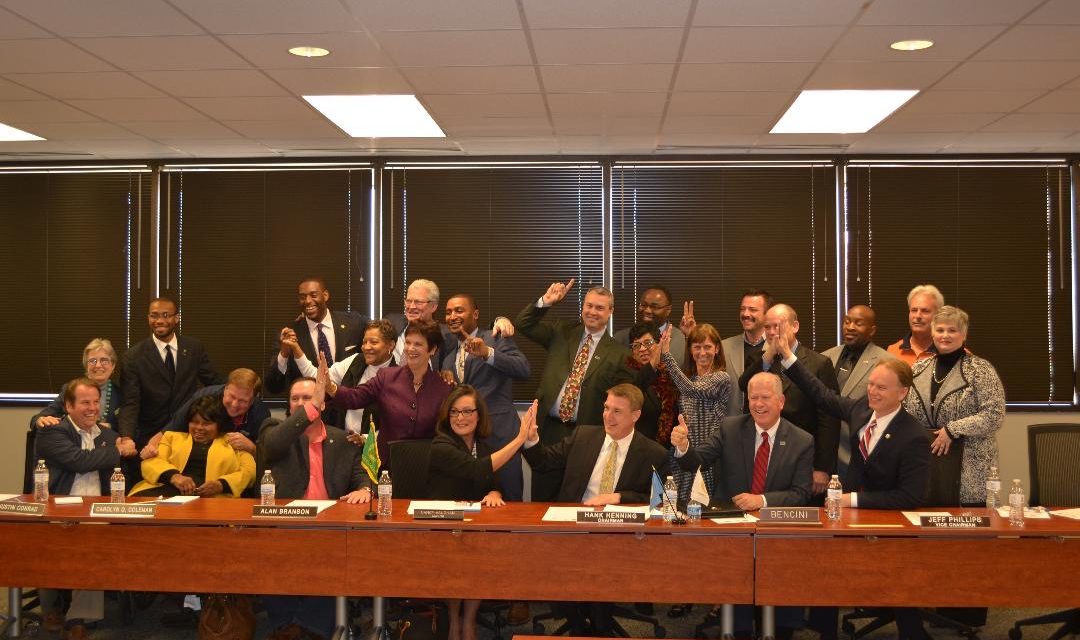For many local leaders, the current success isn’t just the luck of the draw – it is, instead, a culmination of an effort by many people, groups and political bodies in the area who, in 2015, decided to check their egos at the door, cast longstanding local turf battles aside, and work together to bring major businesses to the area.
Getting to that point seven years ago – when the Greensboro City Council, the High Point City Council and the Guilford County Board of Commissioners met together in a large county conference room in downtown Greensboro – was no easy task. Before 2015, Guilford County and its two largest cities were all pursuing their own economic development agendas. To make matters worse, High Point and Greensboro often competed directly against each other for projects interested in this area.
However, finally, by 2015, the three political bodies and disparate economic development groups were all ready to work together on landing big prospects. At a late-summer meeting that year, the Guilford County Economic Development Alliance (GCEDA) was born.
Former Chairman of the Guilford County Board of Commissioners Hank Henning was leading the county in 2015 when that alliance was forged. Henning said he remembered how challenging it was for those backing the alliance to get everyone on the same page and get them to come to an agreement on the details – which, as everyone knows, is where the devil lives.
Henning, who represented High Point constituents as a commissioner, said it took a whole lot of serious discussion before everyone agreed to work together. He said so people many are responsible for the joint effort that it’s hard to name them all. He said everyone from elected leaders to the leaders of various area economic development groups, to those in the private sector like the Joseph M Bryan Foundation, played a key role. Likewise, he said, Greensboro Mayor Nancy Vaughan and former High Point Mayor Bill Bencini were very important to the achievement. Guilford County Manager Marty Lawing, who stepped down as manager one year ago, was a huge advocate and played a major role.
Henning said that that coming together as one was a game-changer.
“Before that, they were competing against each other,” Henning said of the county’s two largest cities. “But then, everyone saw that the important thing was bringing jobs into the community. It didn’t matter where a plant or facility or office was located – what mattered was that this area got the jobs.”
Henning also noted that, in 2015, many people wanted to see solid economic growth in the county but were frustrated by a lack of success.
“I think they came to the realization: ‘This just isn’t working.’” Henning said.
Still, some were reluctant to change.
“The attitude was ‘This is the way we’ve always done it,’” Henning said.
Henning said there was often even tension between the elected leaders and the economic development officials bringing the project to them.
In one closed session meeting of the Guilford County Board of Commissioners, a High Point leader, after High Point was left out of the loop on a giant proposed project near High Point, hit his hand on the desk and said to the economic development official, “Did you think to consult us on this!? Did it occur to you to run this by anyone in High Point?”
One now famous moment for the Board of Commissioners happened when an economic development official and the commissioners were in a closed session discussing a proposed new project at Piedmont Triad International Airport (PTIA). The Charlotte Observer had run a big front-page story about Boeing being interested in PTIA for a major new operation. Even though it had been in the newspaper, the economic development official wouldn’t tell the board what company it was. He kept referring to Boeing by its code name.
“We know it’s Boeing!” one commissioner finally shouted. “It was on the front page of the Charlotte Observer. Can we just say Boeing?”
However, the economic development official in the room refused to acknowledge it was Boeing.
Henning said that, before everyone got on the same page seven years ago, a company would come into the area and be shown around by High Point economic development officials and then come back later for a second visit hosted by Greensboro economic development officials or vice versa.
That often meant giving the client two different sets of data and it also meant that one city would try to shine at the other’s expense.
Henning said it really was quite something to witness all three local government leadership bodies in the same room, and he added he’d never seen anything like it before or since. He said it was a pivotal point in a remarkable transformation of economic development efforts in the county.
“Before that, we were competing against each other,” Henning said.
He said that, after that mid-2015 harmonious convergence, former High Point Economic Development Corp. President Loren Hill and Greensboro Chamber of Commerce President and CEO Brent Christensen began working together.
Henning added that, if Christensen had to be out of town when a Greensboro project was being discussed in a commissioners’ closed session, Hill would fill in – and vice versa.
“They would come to make the presentation even if the project was for the other’s city,” Henning said.
Henning added that Greensboro Mayor Nancy Vaughan played a huge role in the unity effort at that time.
Vaughan said this week that she’s thrilled there are currently so many great prospects for economic development in the area – at the two megasites as well as elsewhere.
She also said there are more projects in the pipeline that aren’t yet known by the media or the general public.
The Greensboro mayor said she thinks the success the community is experiencing now goes back to 2014 and 2015 when there was a shift in the way the county and the two cities thought about economic development. The work between then and now has really paid off, she said.
Vaughan said political and business leaders realized it was much more efficient to work together.
She added that she isn’t sure exactly how the relationship between Greensboro and High Point got so combative in the past – but she was very glad the GCEDA was formed.
“I think that made a huge difference,” the mayor said.
Vaughan said she’s not surprised things finally seem to be hitting on all cylinders.
“I always had faith in the work we’ve been doing,” she said. “My mood has always been optimistic.”
The Greensboro mayor said she’s always known that improvements to the area – such as the Steven Tanger Center for the Performing Arts, local greenway enhancements and the GCEDA – all help make it easier for business leaders to choose Greensboro, High Point and Guilford County. She added that, since the COVID-19 pandemic is getting somewhat under control, big company projects are really ready to get moving.
Vaughan said one important joint move by all three bodies was when each offered financial incentives to keep the headquarters of the Fresh Market in Guilford County in 2019.
Christensen said this week that he’s working all weekend prior to a major economic announcement on Monday, Dec. 6.
Both Henning and Vaughan pointed to the excellent working relationship between Christensen and Hill as a key to success. That relationship is all the more amazing given that Christensen is a die-hard Duke fan while Hill is an equally die-hard UNC-Chapel Hill Tarheel fan.
Like Vaughan, Christensen said the unity effort is reaping benefits.
“This county has been playing the long game and it’s starting to pay off,” he said.
Christensen said he once spoke to a prospect who commented on another jurisdiction where two factions were bad-mouthing one other – each trying to win the project.
“That really turned them off to that area,” he said.
Christensen said it’s much more appealing to prospects when a whole community is working together as one to convince the prospect to open shop here.


Good thing Greensboro’s Mandate Mayor claims bringing jobs close to Greensboro is thanks to her : threats against the 1st and 2nd amendment, languishing underfunded police department, 100 million dollar performance arts monument to the political donor class, sky high unsolved murder rate, gang issues with no dedicated police gang squad, body camera police lawsuits, harassing of the indigent and homeless with unconstitutional ordinances, funding nonprofits run by fellow elected officials, or imposing unilateral shut down mandates willy-nilly on some citizens but not others.
Paying corporate headquarters not to move is the best example of having to pay business not to flee the worst run city in NC.
Wow, work together and you get more done for the benefit of community! Who would have thunk it?! Certainly no one in Washington.
Cooperation, communication, and synergy is the only way to accomplish significant goals for our community. Hats off to entities participating in these efforts.
I remember that being a fun picture. We might need to put the 2015 band back together. Tony Wilkins for City Council.
I’ll tell you about roots. Referring to the barricade cans & cones at W. Market & Guilford College road.
I assumed the final delays were activating the pedestrian lights on all four corners, as if any pedestrian of sound mind would cross there (they usually cross anywhere else, not the intersection). But wait! 50-100 yards east of the intersection, they are jacking up the new asphalt to make a hole. Either they forgot to plug something in, or they made a mistake. Is a civil engineering degree worth anything? Ignert supervisors? Make-work politics? Anyone know?
Can you spot the Sarah Palin, Joe Biden, & Aretha Franklin look-a-likes in the photo?
There’s one of me, too – take a shot.